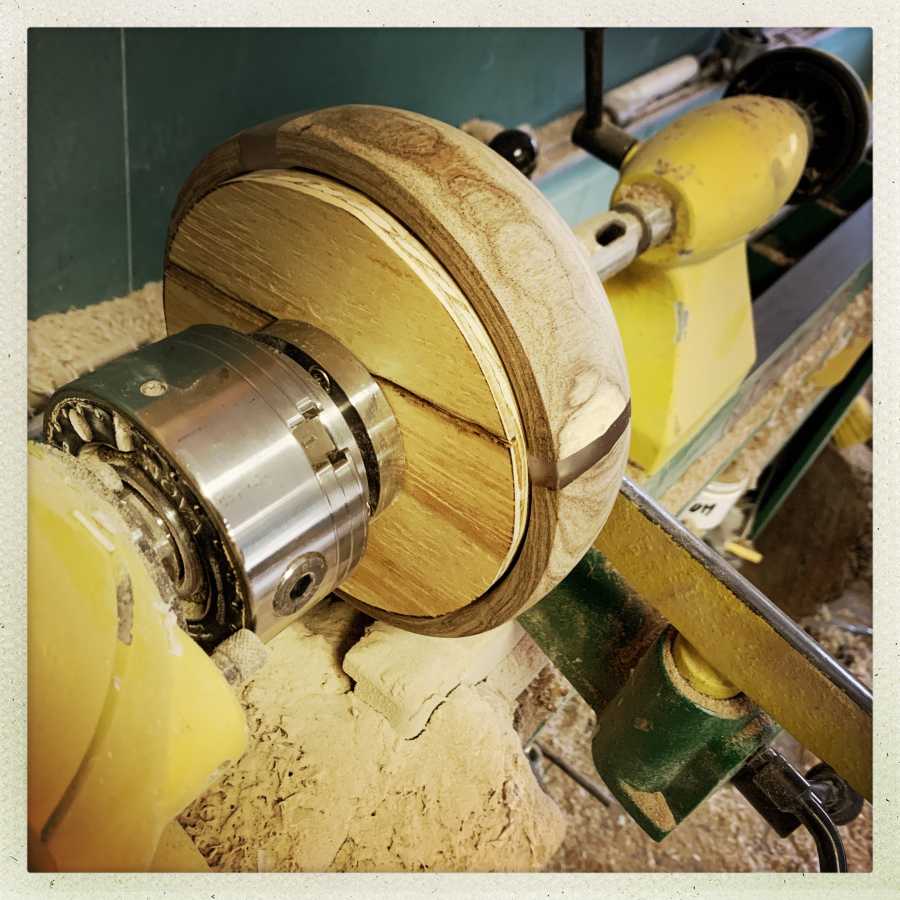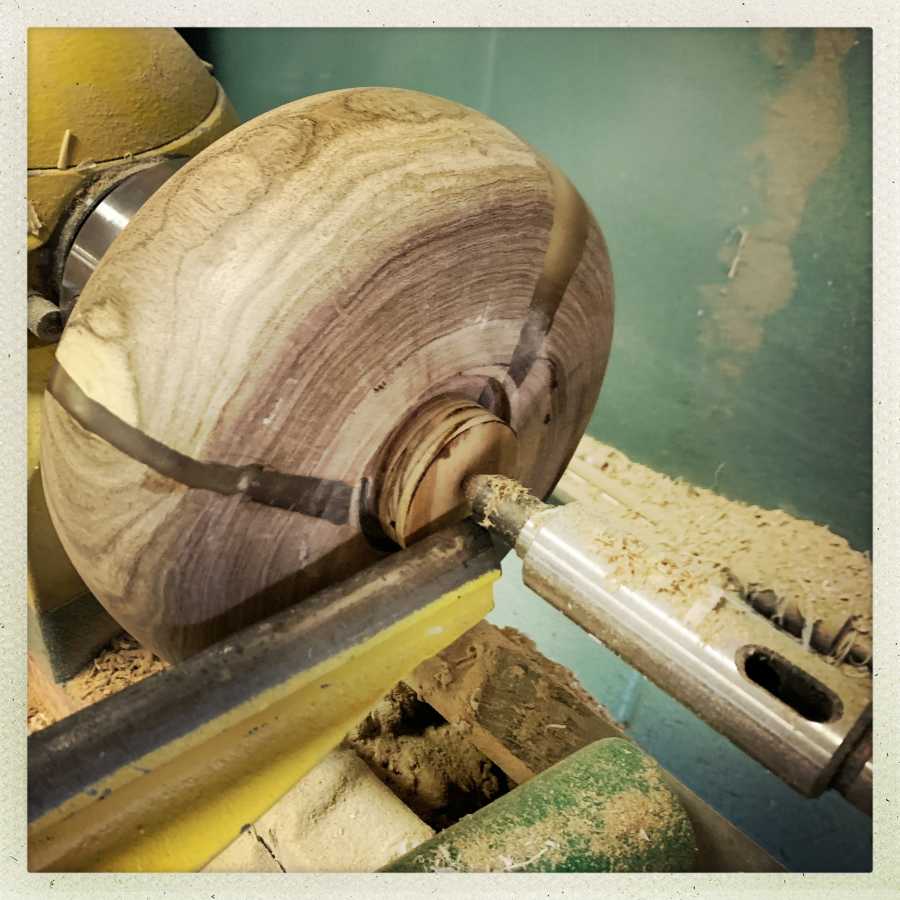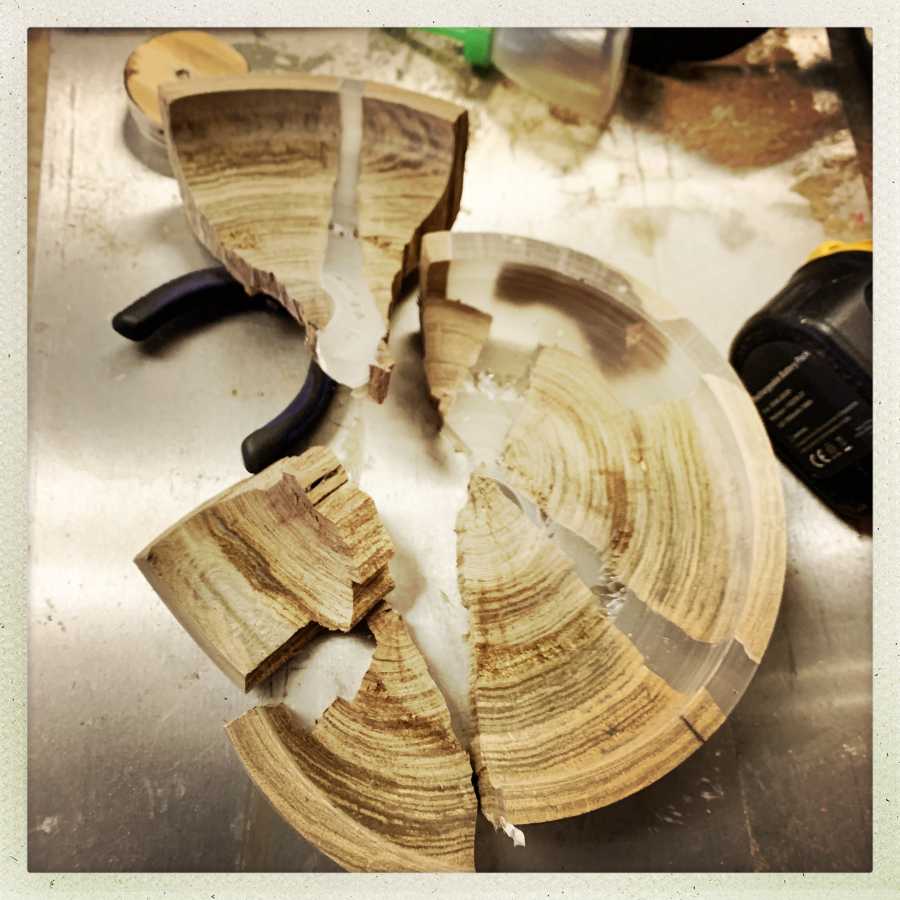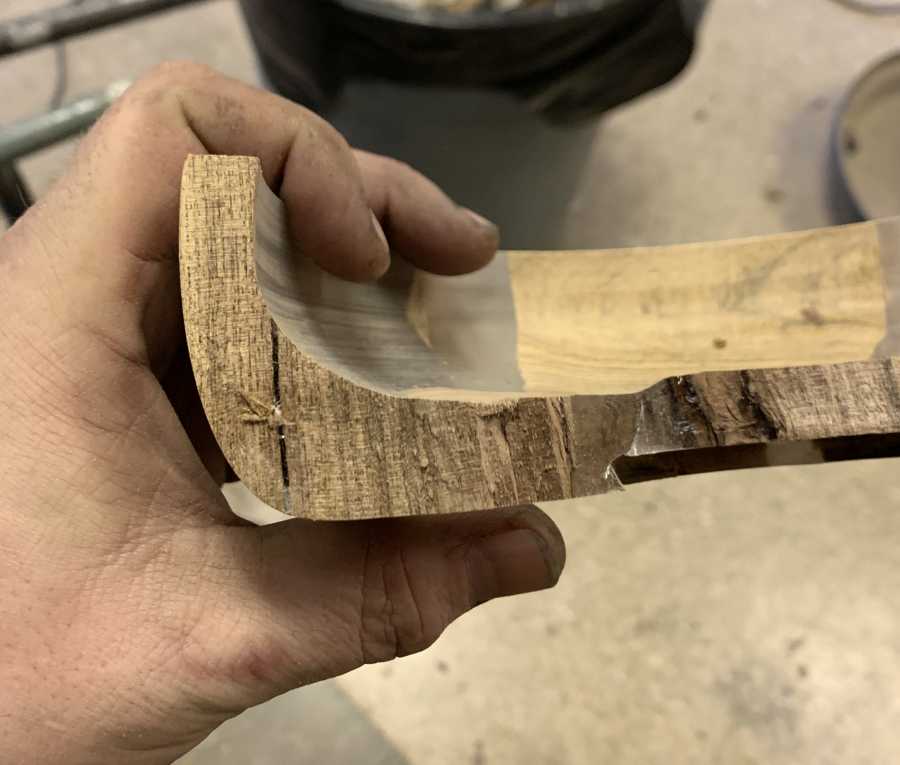We continue the saga of the splintered resin/wood bowl.
To get to the bottom of the bowl, we have a problem: it’s what the chuck holds onto. You do not want to get a hand or tool near, or embroiled with, the chuck when it’s spinning. So, what to do?
I’ve seen a variety of such arrangements, usually involving nice pads and urethane rubber, but I decided that, since I was going to further polish the inside of the bowl, it didn’t matter if I scraped it a bit. So I made a plywood disc that fit into the mouth of the bowl and attached the chuck ring to the plywood, then put another plywood disc in the recess at the back and pressed the whole thing together with the tailstock.

I was surprised how smoothly it worked; the pieces fit so well that there was no wobble in the bowl at all, although I was painfully aware that there was an exposed edge of plywood there, which would act like a saw on anything it came in contact with. So I put the work-rest forward and carefully shaped the bottom with the skew chisel, then sanded it with a block of wood with sandpaper glued to the front.

After that, I felt mightily chuffed. I had managed to do some hard things and everything was turning out lovely. There were a few chips from the carbide bar on the inside of the bowl, and I decided I’d flip the thing around and give it just a touch with a round-nose dull scraper, then sand it and call it done.
I was getting tired and I stuck the scraper in at the wrong angle, it bit, and the bowl shredded apart in an instant, sending wood flying around the room like confetti.
Fortunately, I have adopted a policy of never standing on the axis of my work, so mostly all the big pieces of wood shot past me on their way to somewhere else, but I got a pretty good lesson in “don’t do that” and “here’s why.” I already emphasized using chisels with long handles so I don’t need to get close to anything that’s moving, and I feel that decision is vindicated.

That’s tough material, and the lathe just ripped it apart like it was an eggshell. You can see the huge gouge in the face (near the center, around 3:00) where the scraper bit.
This last picture is interesting:

You can see the lovely dovetail I carved into the bottom recess (with a parting tool) and the graceful curve of the inner bottom. I was really happy about that and now I know what it’ll feel like when I do it again. I took some of the chunks and beat on them and stomped on one, to see if it was just that the material was fragile, but the chunks were still very strong. It’s just that the lathe and the scraper were even stronger. There’s a lot of leverage there.
Live and learn, so long as ye live.

One of the reasons I wanted to describe what is otherwise a massive failure is because I think a lot of the craftspeople on youtube don’t talk about the projects that failed. They wind up looking a lot more successful than perhaps they really are, that way.

Well that’s enough to make a person cry. Or at least pour a stiff drink. It really was turning out very well. You’ve come a long way with the lathe.
I’ve had people ask me how I get my horsehair braiding so perfect (it’s not, actually, but most people can’t tell so we’ll just keep that a secret). I tell them that it was really hard the first 500,000 times and after that, it just started getting easier. It’s true: I started out by screwing it up over and over and over. My favorite saying (which I don’t think I have quite right) is “The man who never made a mistake, never made much of anything.”
Can’t wait to see the next one!
As I have aged, and as erosive arthritis has more or less ruined my hands, I have tried with some success to develop a habit of pausing before using any powered tool. Just for a beat, a checkin. Are my feet planted? Is this grip actually going to work with my fucked up hands? Do I really want a hole *there*?
I sense in this story that you skipped the beat, and went for it. As, to be honest, I do as well. Sometimes something flies across the room when I do.
I have no advice except, uh, don’t do that? Which is what I tell myself.
Oh that being tired but thinking “I’ll just do this little bit and then finish” is soooooo dangerous to the work obviously, but also to the worker.
*Marcus this bit’s horrid!*
I think I have mentioned before that that is how a friend of mine lost her right forefinger and down to the first knuckle on her middle finger, just cutting a piece of wood with the circular saw in the workshop after returning at the end of the day to finish the kitchen fitting she was doing, tired and hit a knot.
Hurts my heart to see this. But you were not hurt and that’s the most important thing.
Yeah, I know those “I’ll just…” moments.
Thankfully, since my projects are small, so are my failures.
But I’ve managed to dip both clothing and hair into resin trying to adjust one little thing, usually after finishing for the night.
Btw, you can save your T if you wash it directly. Your hair, not so much.
Working with the more dangerous tools it can be a blessing not to have a workshop. That means I am limited to sunny hours in the afternoon.
Kestrel
I don’t braid horse hair, but my own and people are often amazed at my crown braids. “I tried that once and it didn’t work”. I tell them that I tried it 30 times and it didn’t work and the next 30 times I looked like a birds nest had exploded on my head.
That exploded pretty nicely, good to hear you weren’t hurt
I don’t know about you, but I would have been swearing up such a storm. An error, though, is often more instructive than a success–if you survive. So climb back into that saddle and ride, baby!
It’s heartbreaking, but thankfully no other part of you was broken. I find the way it fell apart to be curious – not at the seams, but through the wood.
@voyager: well, the log was splitting, so I guess part of the problem is that the wood was not as strong as the resin. The resin is really tough. But the stress a caught chisel produces is severe – it’s a massive twisting on an angle.
publicola@#6:
There was some breathless cursing, it’s true.
Shame about the bowl, it looked nice. But at least you were not harmed.